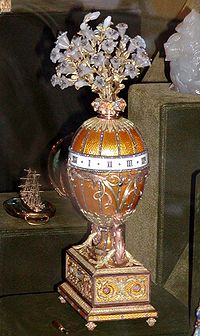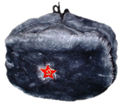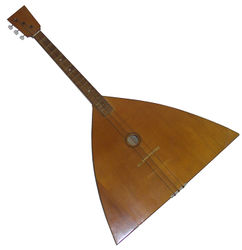Fabergé egg


A Fabergé egg (Russian: Яйца Фаберже; Yaĭtsa Faberzhe; ) is any one of the thousands of jeweled eggs made by the House of Fabergé from 1885 through 1917. The majority of these were miniature ones that were popular gifts at Eastertide. They would be worn on a neck chain either singly or in groups.
The most famous eggs produced by the House were the larger ones made for Alexander III and Nicholas II of Russia. Of the 50 made, 42 have survived.[1] A further two eggs were planned but not delivered, the Constellation and Karelian Birch eggs for 1918, as Nicholas II and his family were assassinated that year, and Nicholas had abdicated the crown the year before.
Seven large eggs were made for the Kelch family of Moscow.[2]
The eggs are made of precious metals or hard stones decorated with combinations of enamel and gem stones. The term "Fabergé egg" has become a synonym of luxury and the eggs are regarded as masterpieces of the jeweller's art. The Fabergé Imperial Easter Eggs are regarded as the last great series of commissions for objets d'art.
Contents |
History
The story began when Tsar Alexander III decided to give his wife the Empress Maria Fedorovna an Easter Egg in 1885, possibly to celebrate the 20th anniversary of their betrothal. It is believed that the Tsar’s inspiration for the piece was an egg owned by the Empress’s aunt, Princess Wilhelmine Marie of Denmark, which had captivated Maria’s imagination in her childhood. Known as the Hen Egg, it is crafted from gold. Its opaque white enamelled ‘shell’ opens to reveal its first surprise, a matte yellow gold yolk. This in turn opens to reveal a multi-coloured gold hen that also opens. It contains a minute diamond replica of the Imperial Crown from which a small ruby pendant was suspended. Unfortunately, these last two surprises have been lost.[3]
Empress Maria was so delighted by this gift that Alexander appointed Fabergé a ‘goldsmith by special appointment to the Imperial Crown’. He commissioned another egg the following year. However, after that, Peter Carl Fabergé, who headed the House, was apparently given complete freedom for future Imperial Easter Eggs, as from this date their designs become more elaborate. According to the Fabergé family tradition, not even the Czar knew what form they would take: the only stipulation was that each one should contain a surprise. Following the death of Alexander III on November 1, 1894, his son presented a Fabergé egg to both his wife, the Empress Alexandra Fedorovna, and to his mother, the Dowager Empress Maria Fedorovna.
No eggs were made for 1904 and 1905 because of the Russo-Japanese War. Once an initial design had been approved by Peter Carl Fabergé, the work was carried out by an entire team of craftsmen, among them Michael Perkhin, Henrik Wigström and Erik August Kollin.
The Imperial eggs enjoyed great fame, and Fabergé made some other large eggs for just a few select private clients, such as the Duchess of Marlborough, the Nobels, the Rothschilds and the Yusupovs. Among them is a series of seven eggs made for the industrialist Alexander Kelch.
List of Fabergé Tsar Imperial Easter eggs
|
|
|
- † Indicates missing egg
List of Fabergé Kelch eggs
- 1898 Hen
- 1899 Twelve Panel
- 1900 Pine Cone
- 1901 Apple Blossom
- 1902 Rocaille
- 1903 Bonbonnière
- 1904 Chanticleer
Other Fabergé eggs
- 1885-1891 Blue Striped Enamel
- 1902 Duchess of Marlborough
- 1902 Rothschild
- 1907 Youssoupov
- 1914 Nobel Ice
- 1885-1889 Resurrection
- 1899-1903 Spring Flowers
Location of eggs
| Location of the Fabergé eggs | Number | |
|---|---|---|
| Imperial: | 42 | |
| Viktor Vekselberg collection, Russia (formerly Forbes) | 9 | |
| Kremlin Armory Museum, Moscow, Russia | 10 | |
| Virginia Museum of Fine Arts, Richmond, Virginia, USA | 5 | |
| Cheekwood Botanical Garden and Museum of Art, Nashville, Tennessee, USA | 3 | |
| Royal Collection, London, UK | 3 | |
| Edouard and Maurice Sandoz Foundation, Switzerland | 2 | |
| Hillwood Museum, Washington, D.C, USA | 2 | |
| Walters Art Museum, Baltimore, Maryland, USA | 2 | |
| Cleveland Museum of Art, Cleveland, Ohio, USA | 1 | |
| Albert II of Monaco collection, Monte-Carlo, Monaco | 1 | |
| The State of Qatar | 1 | |
| Private Collections, USA | 3 | |
| Kelch: | 7 | |
| Viktor Vekselberg collection, Russia (formerly Forbes) | 2 | |
| Royal Collection, London, UK | 1 | |
| Private Collection | 4 | |
| Others: | 8 | |
| Viktor Vekselberg collection, Russia (formerly Forbes) | 2 | |
| Cleveland Museum of Art, Cleveland, Ohio, USA | 1 | |
| Edouard and Maurice Sandoz Foundation, Switzerland | 1 | |
| Russian National Museum, Moscow, Russia | 1 | |
| Private Collection | 3 |
Of the 65 known large Fabergé eggs[4], only 57 have survived to the present day. Ten of the Imperial Easter Eggs are displayed at the Kremlin Armoury Museum, Moscow in Russia. Of the 50 known Imperial eggs, only 42 have survived.
Of the eight lost Imperial eggs, photographs exist of only two,[5] the 1903 Royal Danish, and the 1909 Alexander III Commemorative eggs.
Only one, 1916's Order of St. George egg, left Bolshevik Russia with its original recipient, the Dowager Empress Maria Feodorovna.[6] The rest remained in Petrograd.
Following the Russian Revolution, the House of Fabergé was nationalized by the Bolsheviks, and the Fabergé family fled to Switzerland, where Peter Carl Fabergé died in 1920.[7] The Romanov palaces were ransacked and their treasures moved on order of Vladimir Lenin to the Kremlin Armoury.[7]
In a bid to acquire more foreign currency, Joseph Stalin had many of the eggs sold in 1927, after their value had been appraised by Agathon Fabergé. Between 1930 and 1933 fourteen Imperial eggs left Russia. Many of the eggs were sold to Armand Hammer, president of Occidental Petroleum and a personal friend of Lenin, whose father was founder of the United States Communist party, and Emanuel Snowman of the London antique dealers Wartski.
After the collection in the Kremlin Armoury, the largest gathering of Fabergé eggs was assembled by Malcolm Forbes, and displayed in New York City. Totalling nine eggs, and approximately 180 other Fabergé objects, the collection was put up for auction at Sotheby's in February 2004 by Forbes' heirs. Before the auction even began the collection was purchased in its entirety by the oligarch Victor Vekselberg for a sum estimated between $90 and $120 million. [8]
In November 2007, a Fabergé clock, named by Christie's auction house the Rothschild egg, sold at auction for £8.9 million (including commission).[9] The price achieved by the egg set three auction records: it is the most expensive timepiece, Russian object, and Fabergé object ever sold at auction, surpassing the $9.6 million sale of the 1913 Winter egg in 2002.[10][11]
Gallery
 'Alexander III Equestrian' Egg |
 The Memory of Azov Egg |
The Peter The Great Egg |
See also
- Easter eggs
- Egg decorating
- Guilloché
- Kitsch
References
- ↑ The Fabergé Imperial Easter Eggs,by Fabergé, Skurlov, Proler, London, 1997, page 90. ISBN 0-90343-248-X
- ↑ http://www.mieks.com/Faberge2/Kelch-Eggs/Kelch-Eggs.htm Story of the Kelch eggs from mieks.com
- ↑ http://www.mieks.com/faberge-en/1885-Hen-Egg.htm Article on the first Hen egg
- ↑ The 50 delivered Imperial Eggs, the Karelian Birch Egg, the 7 Kelch Eggs, the Duchess of Marlborough, the Rothschild, the Youssoupov, Nobel, the Resurection, Spring Flowers, and the Blue Striped Enamel eggs - total 65
- ↑ Egg Hunting, Pro Division - Forbes.com
- ↑ Faberge - Treasures of Imperial Russia
- ↑ 7.0 7.1 Faberge Eggs - the fate of the eggs
- ↑ Energy Tribune
- ↑ The clock was previously documented and had been published in 1964 in L'Objet 1900 by Maurice Rheims, plate 29
- ↑ http://news.bbc.co.uk/2/hi/uk_news/7116956.stm Fabergé egg sold for record £8.9m, BBC News, 28 November 2007
- ↑ Bloomberg.com: Muse Arts
Further reading
- Toby Faber. Faberge's Eggs: The Extraordinary Story of the Masterpieces That Outlived an Empire (New York: Random House, 2008) ISBN 978-1-4000-6550-9
- Gerald Hill. Faberge and the Russian Master Goldsmiths (New York: Universe, 2007) ISBN 978-0-7893-9970-0
- Object of Vertu
External links
- Mieks; website on pictures, history, whereabouts... of Fabergé eggs
- Fabergé Research Site by Christel Ludewig McCanless
- Details on each of the Fabergé Eggs
- BYU article on the eggs
- "Oval Objects of Desire," Wall Street Journal review of new history of Faberge eggs
- "FabergeEgg.org," All about Faberge eggs
|
|||||||||||
|
||||||||||||||||||||||||



